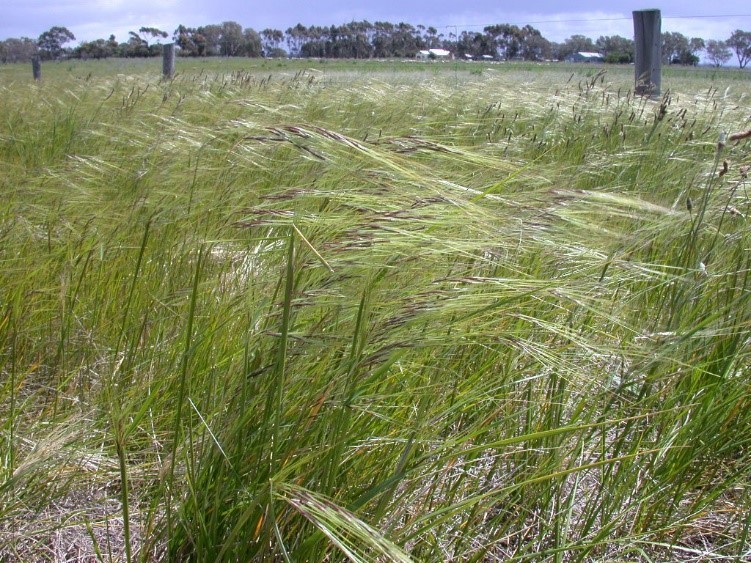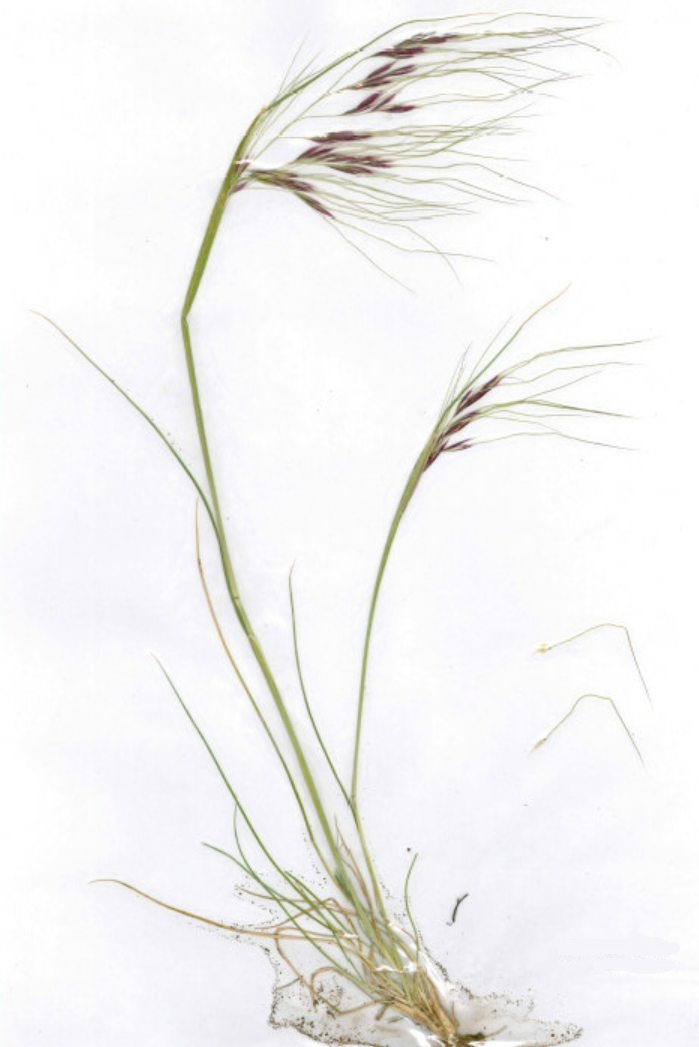Chilean needlegrass is an unpalatable invasive grass, which invades native grassland, severely reduces pasture productivity and can injure stock. It is a Weed of National Significance due to its invasiveness, and economic and environmental impacts.
Description
Chilean needlegrass is a perennial (occurring year to year) tussock grass growing 1–1.5m tall but may be found locally only growing to 60cm high. Leaves are bright to dark green, up to 30cm long and 5mm wide. The leaves are strongly ribbed on the upper surface and rough to touch in one direction because of stiff marginal hairs.
The plant can be confused with some native grasses, in particular spear grasses (Austrostipa species) and wallaby grasses (Austrodanthonia species), and is best identified when flowering in spring and early summer.
The flowering head grows to between 10–40cm long as a loose branching cluster of flowers, and producing 50–200 seeds. These seeds are surrounded by a papery thin scale, light to deep purple in colour, giving the flowering head its distinct colouring.
Chilean needlegrass produces two kinds of seed; normal flowering head seeds and stem seeds.
When ripe, flowering head seeds are pale cream in colour and have a hard and sharp tip. They are small (6–10mm long) and narrow (0.7–1mm wide) with a 6 to 9cm long awn (tail). The awns often twist together at maturity when drying off to form clumps of seeds. Where the awn attaches to the seed there is a raised crown known as a corona. The seed has a beard of silky hair at the pointed tip with a tuft extending in part along the seed.
Stem seeds are produced at the leaf junctions with basal seeds at the very base of the plant. Because the seed grows in the base, control is not as simple as removing the flowering seed head to stop its spread.
Seeds germinate, and vegetation growth occurs mainly in autumn and spring. The plant is relatively dormant over summer.

Impacts
Chilean needlegrass is considered one of Australia’s worst weeds. It impacts on sown pasture, native grasslands and urban and amenity areas of southern and south-eastern Australia. It’s also a weed of neglected areas, along roadsides, and in parks, reserves and sporting grounds with seeds known to cause discomfort for dogs and humans.
As it’s relatively unpalatable, it reduces stock carrying capacity, has low nutritional value and displaces desirable pasture species and native grasses. The sharp needle-like seed, with a natural twisting mechanism, readily penetrates wool, skin and underlying muscle of grazing animals, resulting in injury and the downgrading of wool, hides and carcass products.
This environmental weed also threatens endangered native grasslands. It can rapidly invade native ecosystems and once established it’s difficult to manage. It also degrades grasslands habitat which impacts on native birds and other animals.
Distribution
Chilean needlegrass is native to South America. In South Australia, it was first noted in Lucindale in 1988 and has since been discovered across the Mount Lofty Ranges including at Wirrina and Kangarilla. In the Green Adelaide region there is a significant infestation in the One Tree Hill rural district, with a few smaller outbreaks in the escarpment reserves of the City of Tea Tree Gully and on private property.
New plants grow from seed which fall within a few metres of the parent plant. Infestations occur when the seed is spread along roadsides and in grassy areas via mowing and earth-moving equipment, contaminated soil transported by hooved animals and vehicles, floodwaters which move seed downstream or by people with the seed stuck on their clothing. Native and pest animals (kangaroos, foxes, rabbits and deer) can move seed from infested pastures into native grassy woodlands when moving across the landscape.

Control
Nassella neesiana (Chilean needlegrass) is a declared, notifiable weed under the Landscape South Australia Act 2019 and a Weed of National Significance.
In the Green Adelaide region the sale of Chilean needlegrass or contaminated goods; and its movement into the region, on a public road, and from one part of land to another not affected are prohibited. Land owners must destroy plants on their property and prevent their spread.
We encourage control of plants where there is a risk to biodiversity assets and agricultural enterprises.
Control methods
As Chilean needlegrass closely resembles some native grasses, identification should be confirmed before a control program begins. Consider an integrated approach which can involve a combination of hand removal, herbicide use and competitive plant cover.
Hygiene
Restrict movement of contaminated machinery or soil and clean equipment before leaving a site. Quarantine stock in clean paddocks or yards a week before moving to empty internal paddocks. Shear sheep, remove seed from animal hair and soil packed hooves. Monitor and control these areas for germinations.
Hand removal
Digging out suits the odd plant or small patches, especially in bushland, without the need for herbicide. Carefully grub out the plant using a knife or trowel and remove and destroy the whole plant because of basal and stem seeds. Burn or bury them at least 50cm deep.
Mechanical control
Slashing may reduce seed set by flower heads but can disperse seed if machinery is not kept clean. Controlled intensive grazing at the right time can reduce seed set. Cultivating the soil can stimulate seed to germinate which can then be treated. Sowing dense pasture or crop will reduce germination.
Chemical
Target spot spraying using a knapsack sprayer may be used on small to medium infestations. A boom spray suits larger paddock infestations. There are two registered herbicides for use: glyphosate (non-selective herbicide), or flupropanate (tussock selective and soil residual herbicide).
For advice on chemical options go to PIRSA's Identifying declared weeds.
Near watercourses or sensitive bushland areas with a risk to off-target damage to plants or aquatic species from spraying, consider digging plants out. Site specific advice can be sought from your regional Landscape Officer.
Observations of weeds can be entered into iNaturalist, an app which can assist with identification of species.